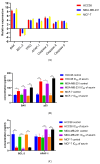The Production of Recombinant Azurin from Pseudomonas aeruginosa and Its Ability to Induce Apoptosis in Various Breast Cancer Cell Lines
- PMID: 40649966
- PMCID: PMC12250392
- DOI: 10.3390/ijms26136188
The Production of Recombinant Azurin from Pseudomonas aeruginosa and Its Ability to Induce Apoptosis in Various Breast Cancer Cell Lines
Abstract
Azurin is a copper-containing redox protein naturally produced by Pseudomonas aeruginosa, which has shown promising activity against human cancer cells by inducing apoptosis. The present study describes the design of a recombinant vector, pT7-MAT-Tag-2-Azu, for azurin production in E. coli cells. The cytotoxic effects of purified azurin were tested on three breast cancer cell lines (MCF-7, MDA-MB-231, and HCC38) and a normal breast epithelial cell line (MCF10A) using the MTT assay. The results showed cytotoxicity against cancer cell lines with minimal effects on normal cells. Further analysis showed that azurin induced apoptosis through mitochondrial pathways, as evidenced by increased expression of apoptosis-related genes (Bax, TP53, Apaf-1, caspase-3, -8, -9) and their corresponding proteins, elevated levels of reactive oxygen species (ROS), and DNA damage, mitochondrial membrane potential (MMP), or brine shrimp lethality assay. Furthermore, in silico molecular docking, simulations predicted a stable, electrostatically driven interaction between azurin and the p53 protein, providing a structural basis for its mechanism of action. These findings suggest that recombinant azurin may serve as a potential therapeutic agent for breast cancer after further multifaceted research.
Keywords: anticancer; apoptosis; azurin; breast cancer; recombinant proteins.
Conflict of interest statement
The authors declare that they have no known competing financial interests or personal relationships that could have appeared to influence the work reported in this paper.
Figures











Similar articles
-
Azurin a potent anticancer and antimicrobial agent isolated from a novel Pseudomonas aeruginosa strain.Sci Rep. 2025 Jan 30;15(1):3735. doi: 10.1038/s41598-025-86649-w. Sci Rep. 2025. PMID: 39885219 Free PMC article.
-
Novel indole Schiff base β-diiminato compound as an anti-cancer agent against triple-negative breast cancer: In vitro anticancer activity evaluation and in vivo acute toxicity study.Bioorg Chem. 2024 Nov;152:107730. doi: 10.1016/j.bioorg.2024.107730. Epub 2024 Aug 16. Bioorg Chem. 2024. PMID: 39216194
-
Novel benzenesulfonamides as dual VEGFR2/FGFR1 inhibitors targeting breast cancer: Design, synthesis, anticancer activity and in silico studies.Bioorg Chem. 2024 Nov;152:107728. doi: 10.1016/j.bioorg.2024.107728. Epub 2024 Aug 17. Bioorg Chem. 2024. PMID: 39178704
-
Cost-effectiveness of using prognostic information to select women with breast cancer for adjuvant systemic therapy.Health Technol Assess. 2006 Sep;10(34):iii-iv, ix-xi, 1-204. doi: 10.3310/hta10340. Health Technol Assess. 2006. PMID: 16959170
-
A systematic review and economic evaluation of epoetin alpha, epoetin beta and darbepoetin alpha in anaemia associated with cancer, especially that attributable to cancer treatment.Health Technol Assess. 2007 Apr;11(13):1-202, iii-iv. doi: 10.3310/hta11130. Health Technol Assess. 2007. PMID: 17408534
References
-
- Maiorella B., Inlow D., Shauger A., Harano D. Large-Scale Insect Cell-Culture for Recombinant Protein Production. Bio/Technol. 1988;6:1406–1410. doi: 10.1038/nbt1288-1406. - DOI
MeSH terms
Substances
Grants and funding
LinkOut - more resources
Full Text Sources
Medical
Research Materials
Miscellaneous

